University Auditing Theory and Practice: Financial Analysis Report
VerifiedAdded on 2023/06/07
|18
|4333
|330
Report
AI Summary
This report examines auditing theory and practice, focusing on financial analysis and risk assessment within the context of the company TCW. The report begins with an abstract outlining the key areas of investigation, including audit and business risks. It then delves into a detailed analysis of specific accounts like accounts receivable, investments, property assets, and marketing expenses, identifying associated audit risks and recommending mitigation strategies. The report also explores business risks through financial ratio analysis, including return on equity, gross margin, and various operational ratios. The analysis includes comparisons of audited and unaudited financial data, providing insights into the company's performance and potential areas of concern. Furthermore, the report considers internal controls and their impact on operational effectiveness and efficiency, aligning with assurance objectives.
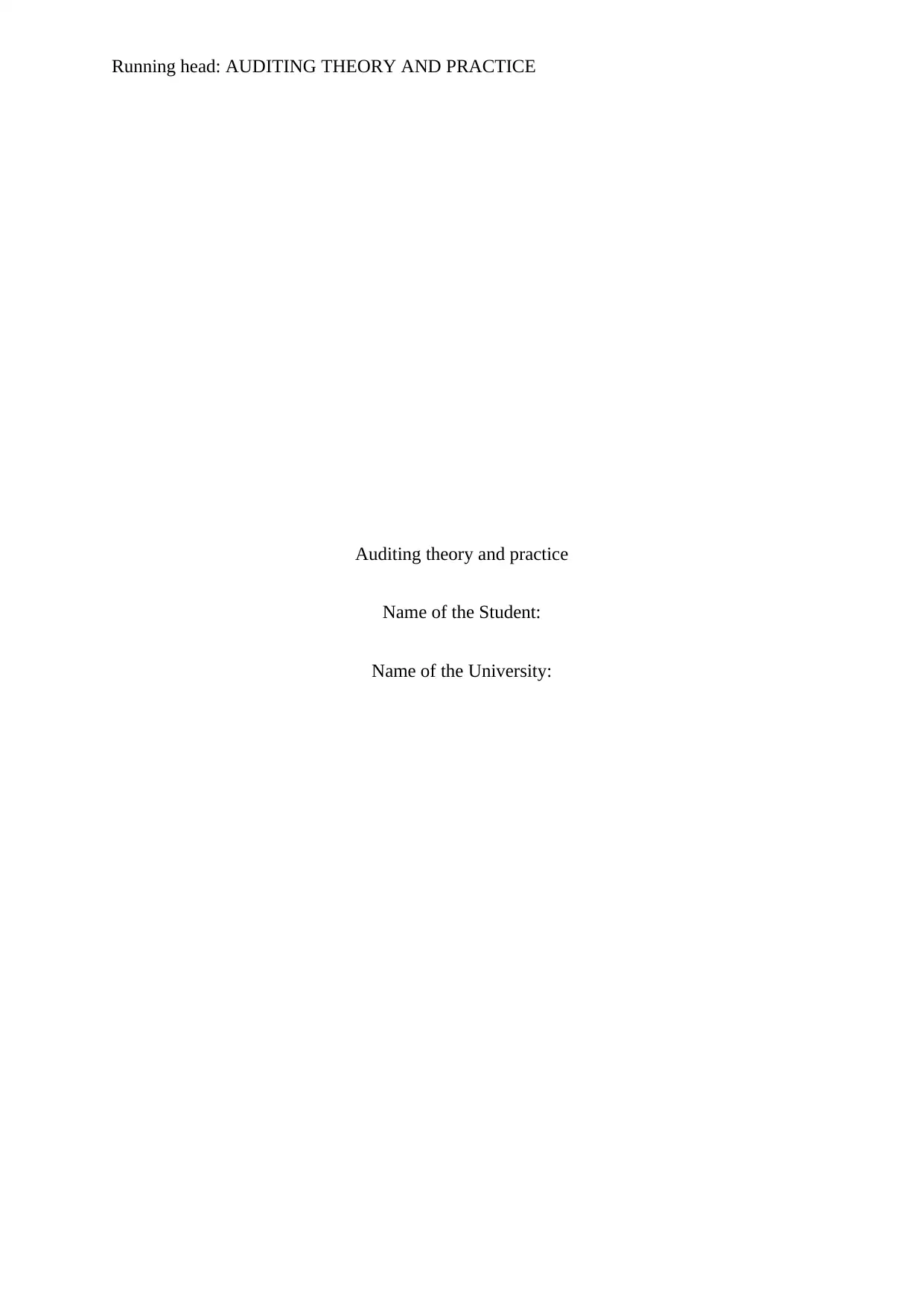
Running head: AUDITING THEORY AND PRACTICE
Auditing theory and practice
Name of the Student:
Name of the University:
Auditing theory and practice
Name of the Student:
Name of the University:
Paraphrase This Document
Need a fresh take? Get an instant paraphrase of this document with our AI Paraphraser
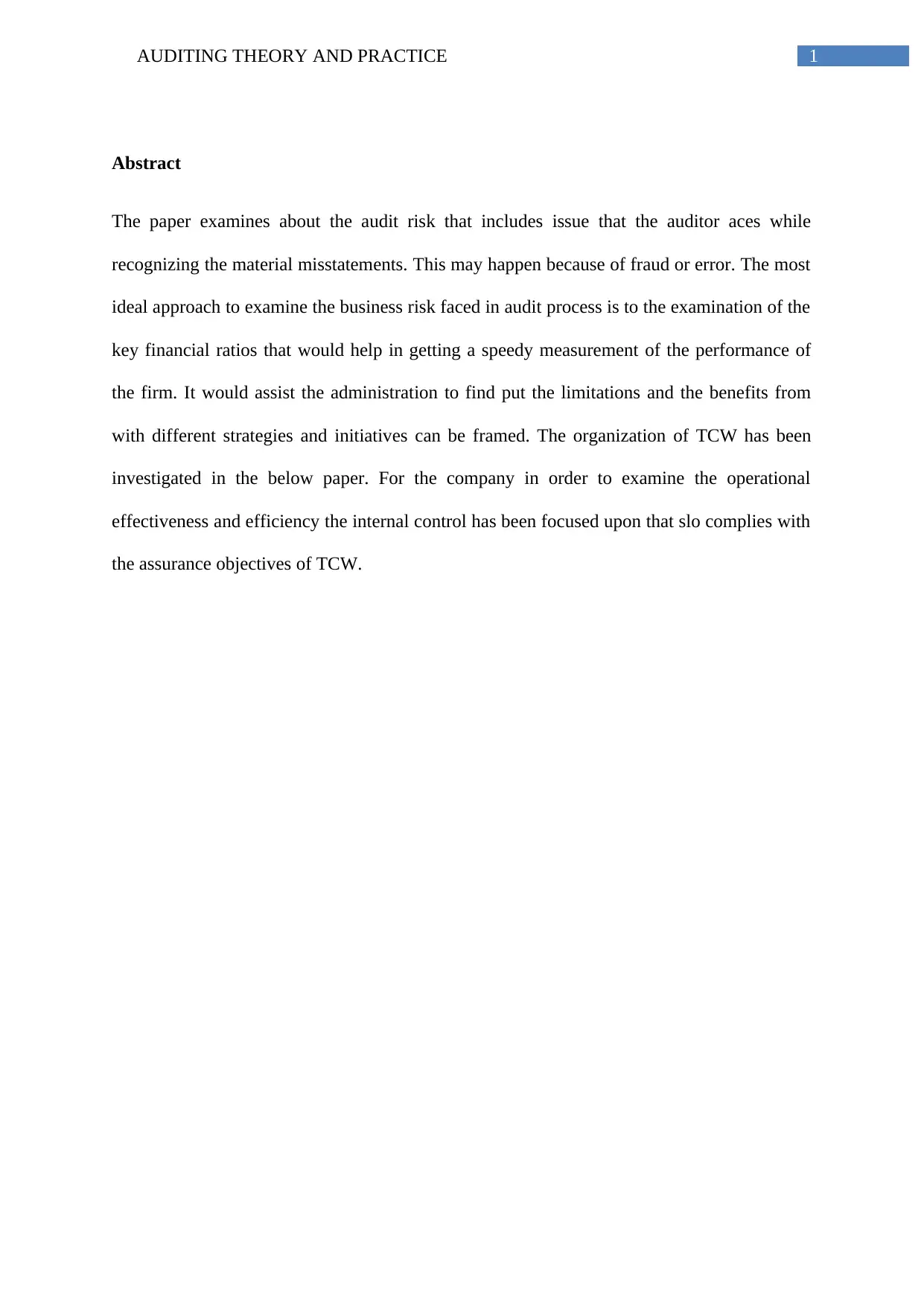
1AUDITING THEORY AND PRACTICE
Abstract
The paper examines about the audit risk that includes issue that the auditor aces while
recognizing the material misstatements. This may happen because of fraud or error. The most
ideal approach to examine the business risk faced in audit process is to the examination of the
key financial ratios that would help in getting a speedy measurement of the performance of
the firm. It would assist the administration to find put the limitations and the benefits from
with different strategies and initiatives can be framed. The organization of TCW has been
investigated in the below paper. For the company in order to examine the operational
effectiveness and efficiency the internal control has been focused upon that slo complies with
the assurance objectives of TCW.
Abstract
The paper examines about the audit risk that includes issue that the auditor aces while
recognizing the material misstatements. This may happen because of fraud or error. The most
ideal approach to examine the business risk faced in audit process is to the examination of the
key financial ratios that would help in getting a speedy measurement of the performance of
the firm. It would assist the administration to find put the limitations and the benefits from
with different strategies and initiatives can be framed. The organization of TCW has been
investigated in the below paper. For the company in order to examine the operational
effectiveness and efficiency the internal control has been focused upon that slo complies with
the assurance objectives of TCW.
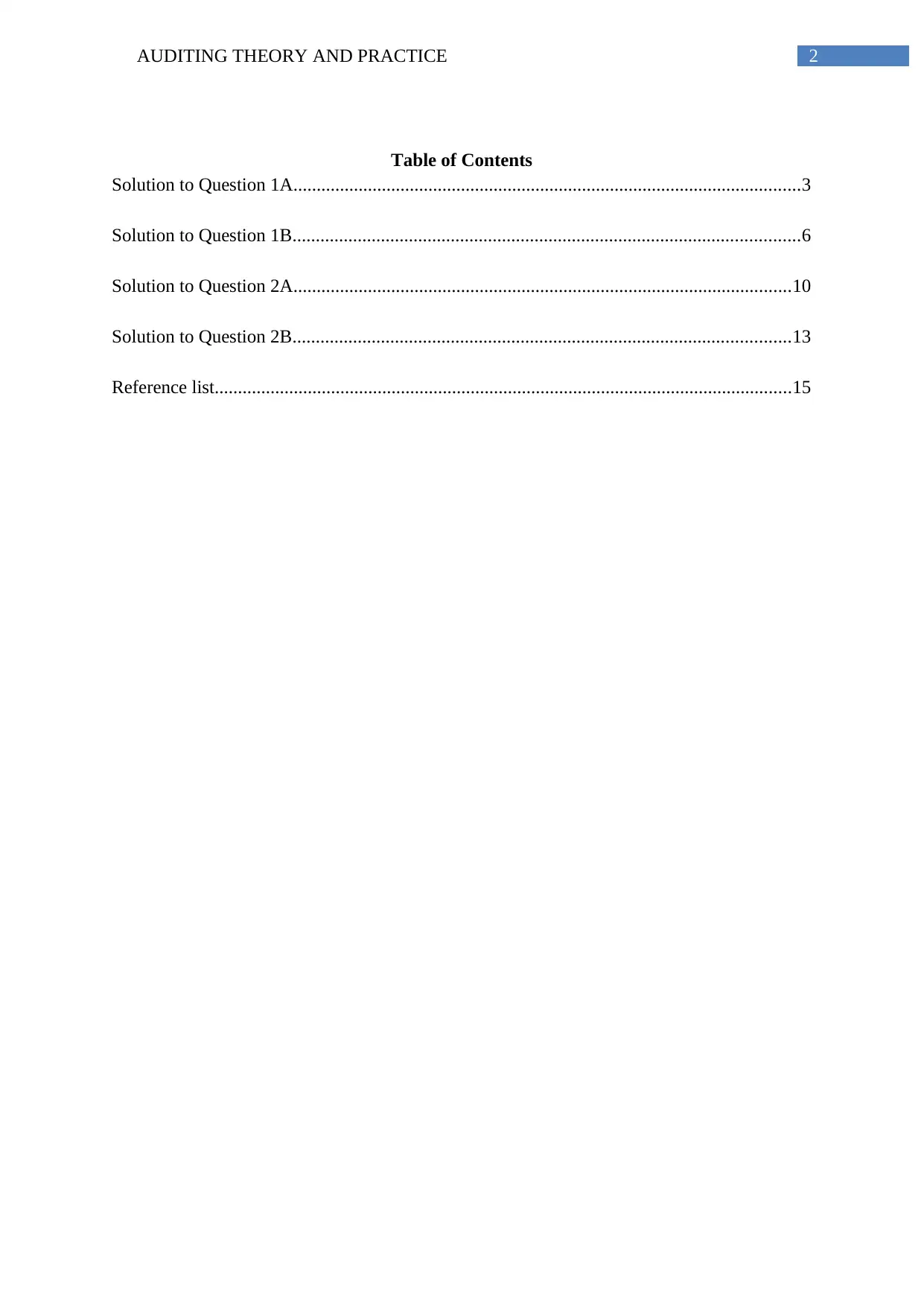
2AUDITING THEORY AND PRACTICE
Table of Contents
Solution to Question 1A.............................................................................................................3
Solution to Question 1B.............................................................................................................6
Solution to Question 2A...........................................................................................................10
Solution to Question 2B...........................................................................................................13
Reference list............................................................................................................................15
Table of Contents
Solution to Question 1A.............................................................................................................3
Solution to Question 1B.............................................................................................................6
Solution to Question 2A...........................................................................................................10
Solution to Question 2B...........................................................................................................13
Reference list............................................................................................................................15
⊘ This is a preview!⊘
Do you want full access?
Subscribe today to unlock all pages.

Trusted by 1+ million students worldwide
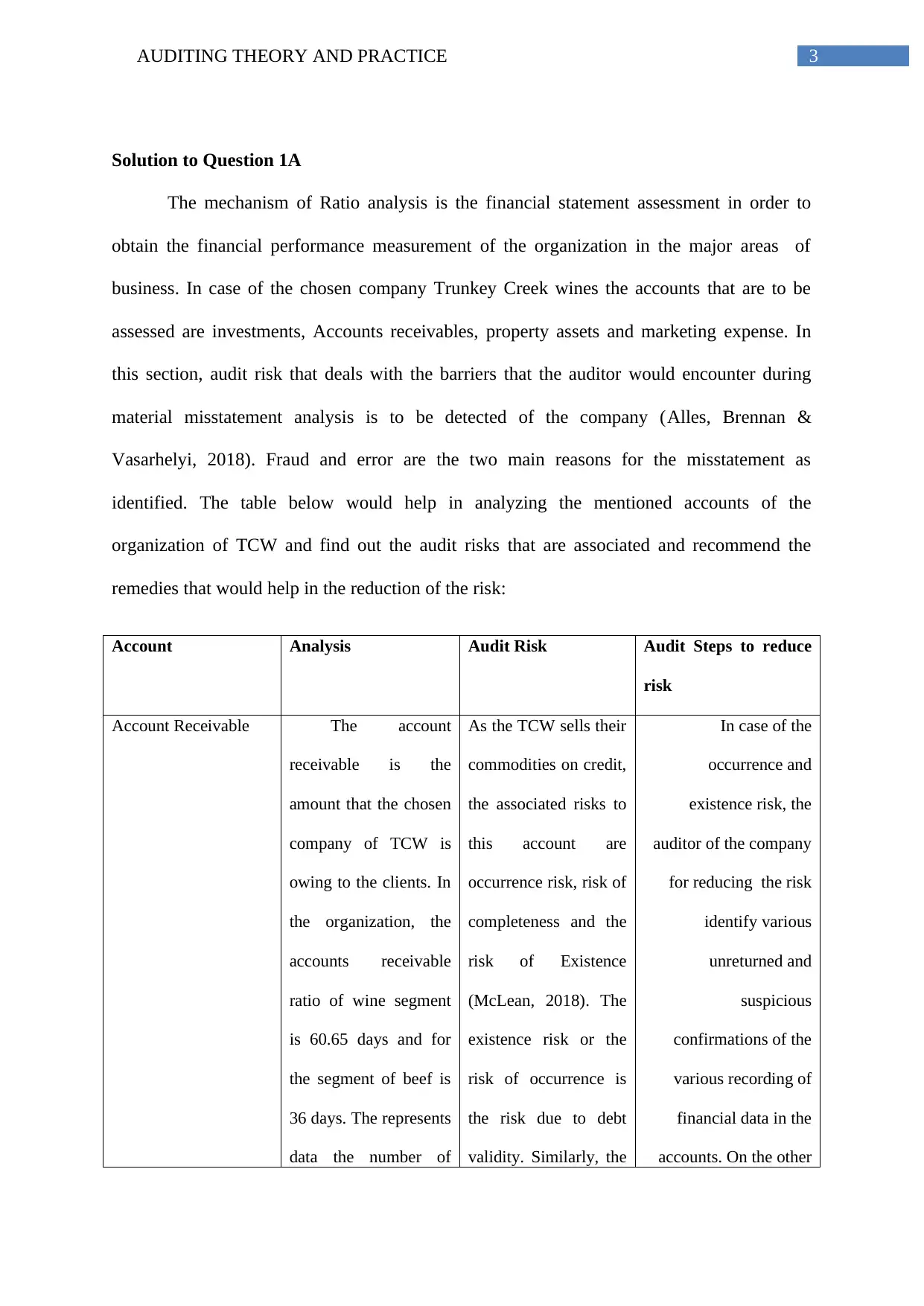
3AUDITING THEORY AND PRACTICE
Solution to Question 1A
The mechanism of Ratio analysis is the financial statement assessment in order to
obtain the financial performance measurement of the organization in the major areas of
business. In case of the chosen company Trunkey Creek wines the accounts that are to be
assessed are investments, Accounts receivables, property assets and marketing expense. In
this section, audit risk that deals with the barriers that the auditor would encounter during
material misstatement analysis is to be detected of the company (Alles, Brennan &
Vasarhelyi, 2018). Fraud and error are the two main reasons for the misstatement as
identified. The table below would help in analyzing the mentioned accounts of the
organization of TCW and find out the audit risks that are associated and recommend the
remedies that would help in the reduction of the risk:
Account Analysis Audit Risk Audit Steps to reduce
risk
Account Receivable The account
receivable is the
amount that the chosen
company of TCW is
owing to the clients. In
the organization, the
accounts receivable
ratio of wine segment
is 60.65 days and for
the segment of beef is
36 days. The represents
data the number of
As the TCW sells their
commodities on credit,
the associated risks to
this account are
occurrence risk, risk of
completeness and the
risk of Existence
(McLean, 2018). The
existence risk or the
risk of occurrence is
the risk due to debt
validity. Similarly, the
In case of the
occurrence and
existence risk, the
auditor of the company
for reducing the risk
identify various
unreturned and
suspicious
confirmations of the
various recording of
financial data in the
accounts. On the other
Solution to Question 1A
The mechanism of Ratio analysis is the financial statement assessment in order to
obtain the financial performance measurement of the organization in the major areas of
business. In case of the chosen company Trunkey Creek wines the accounts that are to be
assessed are investments, Accounts receivables, property assets and marketing expense. In
this section, audit risk that deals with the barriers that the auditor would encounter during
material misstatement analysis is to be detected of the company (Alles, Brennan &
Vasarhelyi, 2018). Fraud and error are the two main reasons for the misstatement as
identified. The table below would help in analyzing the mentioned accounts of the
organization of TCW and find out the audit risks that are associated and recommend the
remedies that would help in the reduction of the risk:
Account Analysis Audit Risk Audit Steps to reduce
risk
Account Receivable The account
receivable is the
amount that the chosen
company of TCW is
owing to the clients. In
the organization, the
accounts receivable
ratio of wine segment
is 60.65 days and for
the segment of beef is
36 days. The represents
data the number of
As the TCW sells their
commodities on credit,
the associated risks to
this account are
occurrence risk, risk of
completeness and the
risk of Existence
(McLean, 2018). The
existence risk or the
risk of occurrence is
the risk due to debt
validity. Similarly, the
In case of the
occurrence and
existence risk, the
auditor of the company
for reducing the risk
identify various
unreturned and
suspicious
confirmations of the
various recording of
financial data in the
accounts. On the other
Paraphrase This Document
Need a fresh take? Get an instant paraphrase of this document with our AI Paraphraser
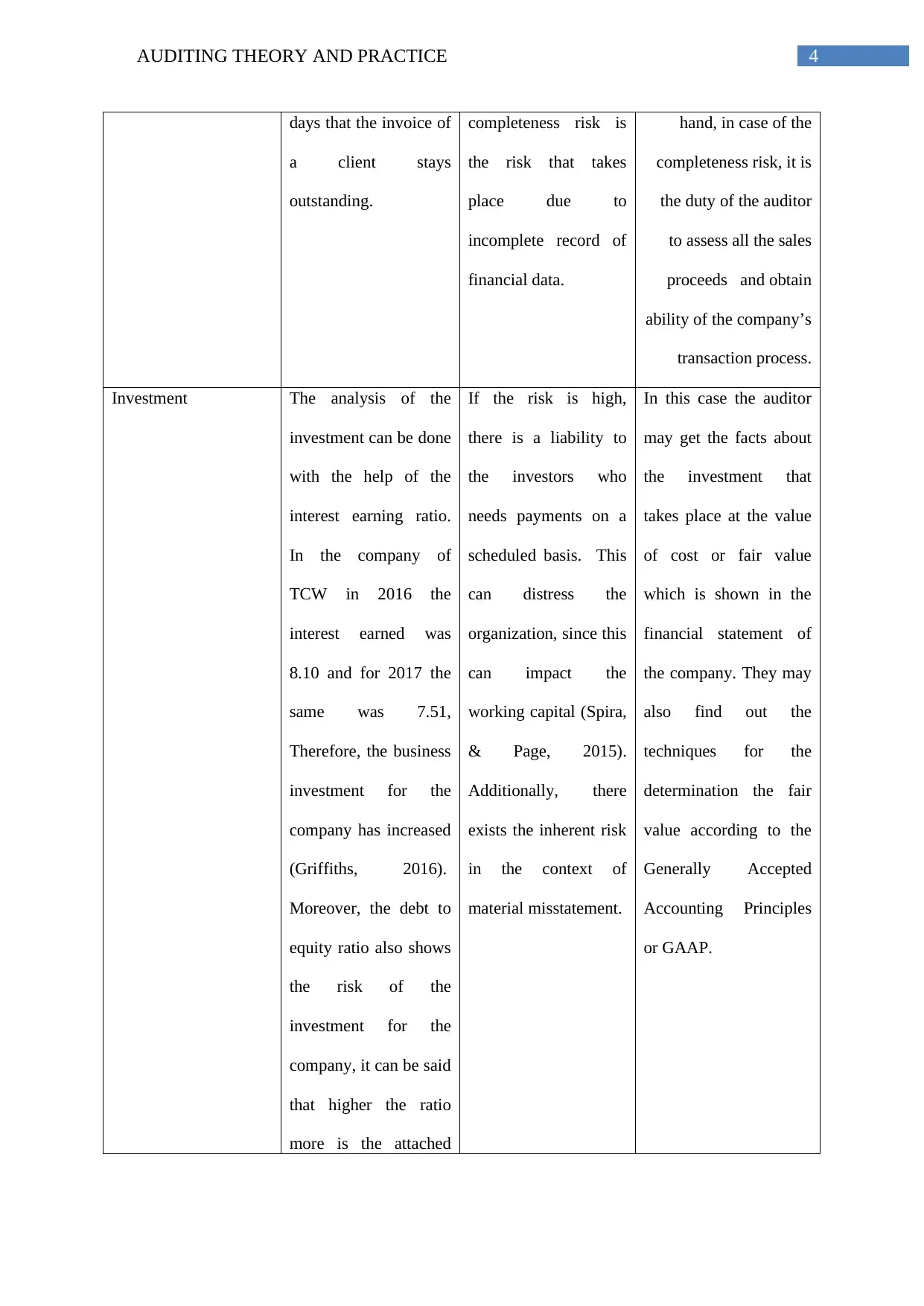
4AUDITING THEORY AND PRACTICE
days that the invoice of
a client stays
outstanding.
completeness risk is
the risk that takes
place due to
incomplete record of
financial data.
hand, in case of the
completeness risk, it is
the duty of the auditor
to assess all the sales
proceeds and obtain
ability of the company’s
transaction process.
Investment The analysis of the
investment can be done
with the help of the
interest earning ratio.
In the company of
TCW in 2016 the
interest earned was
8.10 and for 2017 the
same was 7.51,
Therefore, the business
investment for the
company has increased
(Griffiths, 2016).
Moreover, the debt to
equity ratio also shows
the risk of the
investment for the
company, it can be said
that higher the ratio
more is the attached
If the risk is high,
there is a liability to
the investors who
needs payments on a
scheduled basis. This
can distress the
organization, since this
can impact the
working capital (Spira,
& Page, 2015).
Additionally, there
exists the inherent risk
in the context of
material misstatement.
In this case the auditor
may get the facts about
the investment that
takes place at the value
of cost or fair value
which is shown in the
financial statement of
the company. They may
also find out the
techniques for the
determination the fair
value according to the
Generally Accepted
Accounting Principles
or GAAP.
days that the invoice of
a client stays
outstanding.
completeness risk is
the risk that takes
place due to
incomplete record of
financial data.
hand, in case of the
completeness risk, it is
the duty of the auditor
to assess all the sales
proceeds and obtain
ability of the company’s
transaction process.
Investment The analysis of the
investment can be done
with the help of the
interest earning ratio.
In the company of
TCW in 2016 the
interest earned was
8.10 and for 2017 the
same was 7.51,
Therefore, the business
investment for the
company has increased
(Griffiths, 2016).
Moreover, the debt to
equity ratio also shows
the risk of the
investment for the
company, it can be said
that higher the ratio
more is the attached
If the risk is high,
there is a liability to
the investors who
needs payments on a
scheduled basis. This
can distress the
organization, since this
can impact the
working capital (Spira,
& Page, 2015).
Additionally, there
exists the inherent risk
in the context of
material misstatement.
In this case the auditor
may get the facts about
the investment that
takes place at the value
of cost or fair value
which is shown in the
financial statement of
the company. They may
also find out the
techniques for the
determination the fair
value according to the
Generally Accepted
Accounting Principles
or GAAP.
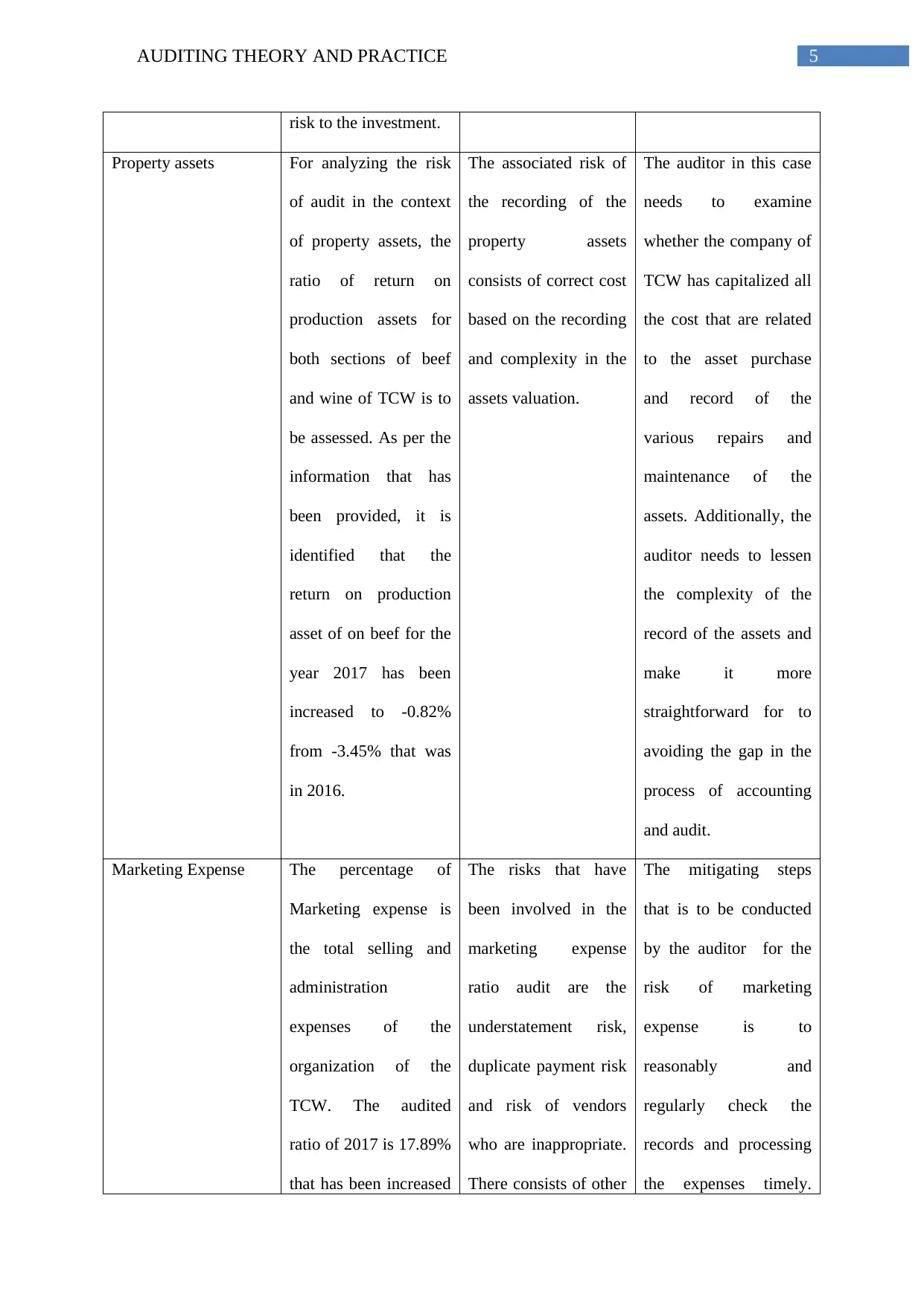
5AUDITING THEORY AND PRACTICE
risk to the investment.
Property assets For analyzing the risk
of audit in the context
of property assets, the
ratio of return on
production assets for
both sections of beef
and wine of TCW is to
be assessed. As per the
information that has
been provided, it is
identified that the
return on production
asset of on beef for the
year 2017 has been
increased to -0.82%
from -3.45% that was
in 2016.
The associated risk of
the recording of the
property assets
consists of correct cost
based on the recording
and complexity in the
assets valuation.
The auditor in this case
needs to examine
whether the company of
TCW has capitalized all
the cost that are related
to the asset purchase
and record of the
various repairs and
maintenance of the
assets. Additionally, the
auditor needs to lessen
the complexity of the
record of the assets and
make it more
straightforward for to
avoiding the gap in the
process of accounting
and audit.
Marketing Expense The percentage of
Marketing expense is
the total selling and
administration
expenses of the
organization of the
TCW. The audited
ratio of 2017 is 17.89%
that has been increased
The risks that have
been involved in the
marketing expense
ratio audit are the
understatement risk,
duplicate payment risk
and risk of vendors
who are inappropriate.
There consists of other
The mitigating steps
that is to be conducted
by the auditor for the
risk of marketing
expense is to
reasonably and
regularly check the
records and processing
the expenses timely.
risk to the investment.
Property assets For analyzing the risk
of audit in the context
of property assets, the
ratio of return on
production assets for
both sections of beef
and wine of TCW is to
be assessed. As per the
information that has
been provided, it is
identified that the
return on production
asset of on beef for the
year 2017 has been
increased to -0.82%
from -3.45% that was
in 2016.
The associated risk of
the recording of the
property assets
consists of correct cost
based on the recording
and complexity in the
assets valuation.
The auditor in this case
needs to examine
whether the company of
TCW has capitalized all
the cost that are related
to the asset purchase
and record of the
various repairs and
maintenance of the
assets. Additionally, the
auditor needs to lessen
the complexity of the
record of the assets and
make it more
straightforward for to
avoiding the gap in the
process of accounting
and audit.
Marketing Expense The percentage of
Marketing expense is
the total selling and
administration
expenses of the
organization of the
TCW. The audited
ratio of 2017 is 17.89%
that has been increased
The risks that have
been involved in the
marketing expense
ratio audit are the
understatement risk,
duplicate payment risk
and risk of vendors
who are inappropriate.
There consists of other
The mitigating steps
that is to be conducted
by the auditor for the
risk of marketing
expense is to
reasonably and
regularly check the
records and processing
the expenses timely.
⊘ This is a preview!⊘
Do you want full access?
Subscribe today to unlock all pages.

Trusted by 1+ million students worldwide
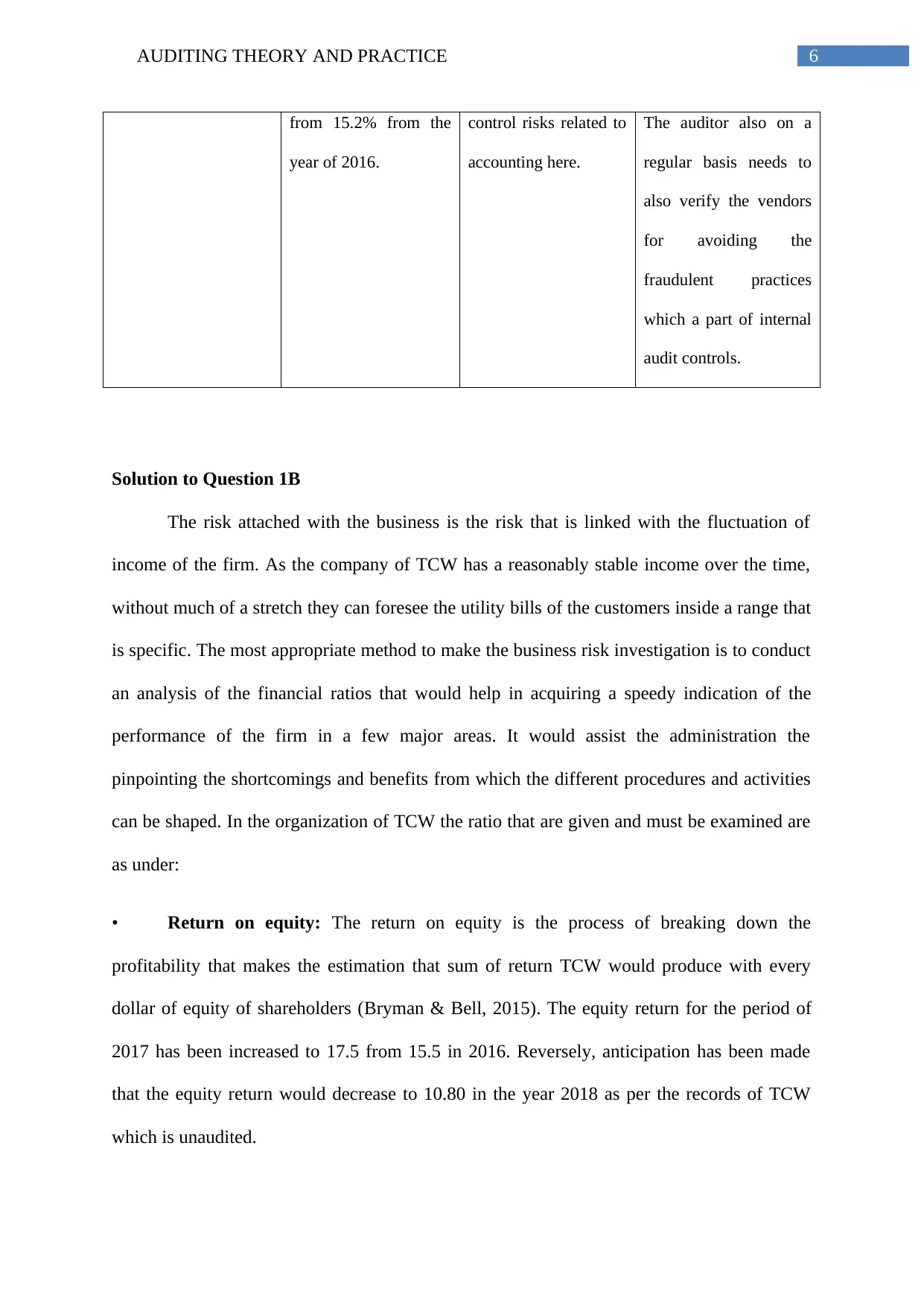
6AUDITING THEORY AND PRACTICE
from 15.2% from the
year of 2016.
control risks related to
accounting here.
The auditor also on a
regular basis needs to
also verify the vendors
for avoiding the
fraudulent practices
which a part of internal
audit controls.
Solution to Question 1B
The risk attached with the business is the risk that is linked with the fluctuation of
income of the firm. As the company of TCW has a reasonably stable income over the time,
without much of a stretch they can foresee the utility bills of the customers inside a range that
is specific. The most appropriate method to make the business risk investigation is to conduct
an analysis of the financial ratios that would help in acquiring a speedy indication of the
performance of the firm in a few major areas. It would assist the administration the
pinpointing the shortcomings and benefits from which the different procedures and activities
can be shaped. In the organization of TCW the ratio that are given and must be examined are
as under:
• Return on equity: The return on equity is the process of breaking down the
profitability that makes the estimation that sum of return TCW would produce with every
dollar of equity of shareholders (Bryman & Bell, 2015). The equity return for the period of
2017 has been increased to 17.5 from 15.5 in 2016. Reversely, anticipation has been made
that the equity return would decrease to 10.80 in the year 2018 as per the records of TCW
which is unaudited.
from 15.2% from the
year of 2016.
control risks related to
accounting here.
The auditor also on a
regular basis needs to
also verify the vendors
for avoiding the
fraudulent practices
which a part of internal
audit controls.
Solution to Question 1B
The risk attached with the business is the risk that is linked with the fluctuation of
income of the firm. As the company of TCW has a reasonably stable income over the time,
without much of a stretch they can foresee the utility bills of the customers inside a range that
is specific. The most appropriate method to make the business risk investigation is to conduct
an analysis of the financial ratios that would help in acquiring a speedy indication of the
performance of the firm in a few major areas. It would assist the administration the
pinpointing the shortcomings and benefits from which the different procedures and activities
can be shaped. In the organization of TCW the ratio that are given and must be examined are
as under:
• Return on equity: The return on equity is the process of breaking down the
profitability that makes the estimation that sum of return TCW would produce with every
dollar of equity of shareholders (Bryman & Bell, 2015). The equity return for the period of
2017 has been increased to 17.5 from 15.5 in 2016. Reversely, anticipation has been made
that the equity return would decrease to 10.80 in the year 2018 as per the records of TCW
which is unaudited.
Paraphrase This Document
Need a fresh take? Get an instant paraphrase of this document with our AI Paraphraser
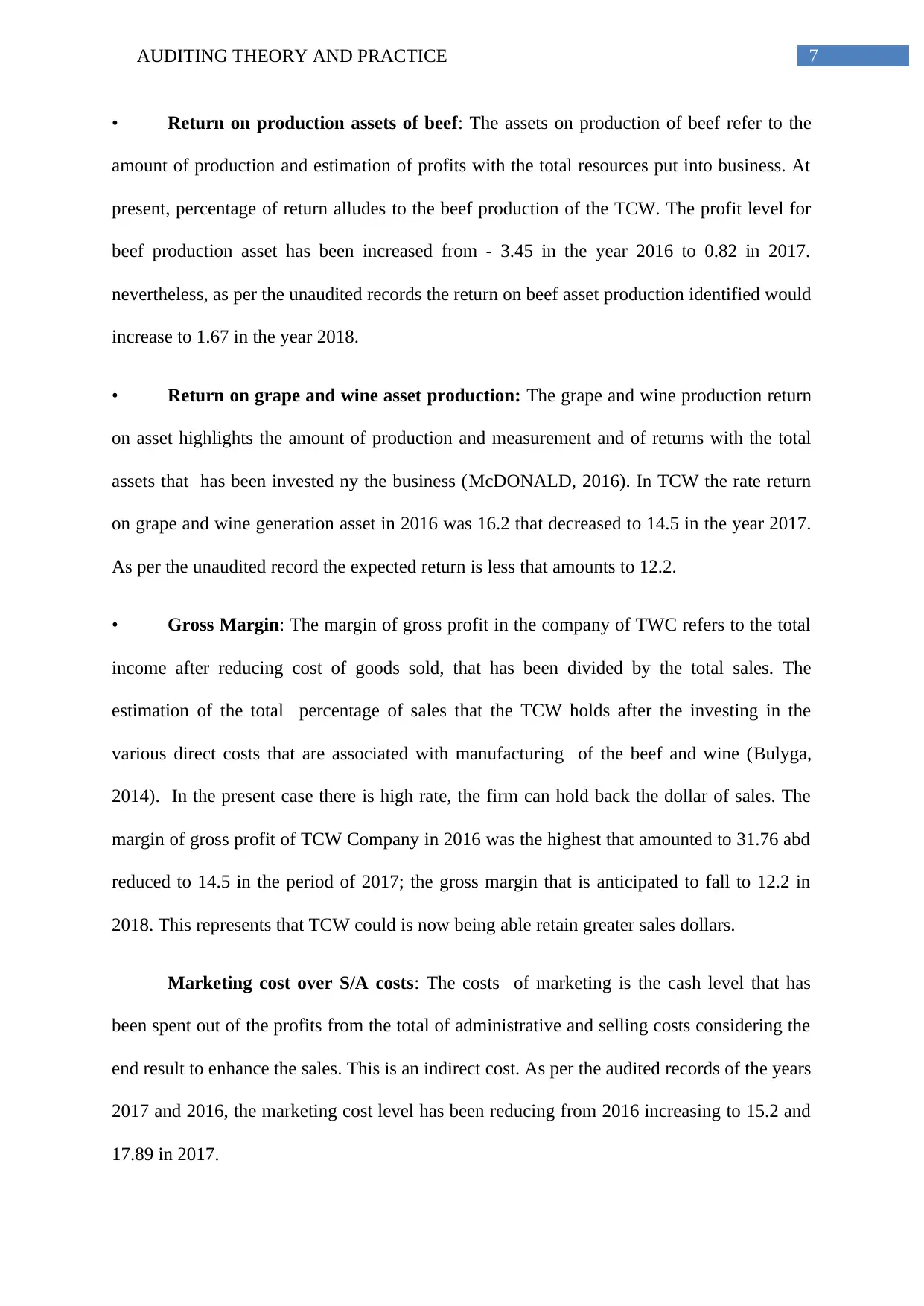
7AUDITING THEORY AND PRACTICE
• Return on production assets of beef: The assets on production of beef refer to the
amount of production and estimation of profits with the total resources put into business. At
present, percentage of return alludes to the beef production of the TCW. The profit level for
beef production asset has been increased from - 3.45 in the year 2016 to 0.82 in 2017.
nevertheless, as per the unaudited records the return on beef asset production identified would
increase to 1.67 in the year 2018.
• Return on grape and wine asset production: The grape and wine production return
on asset highlights the amount of production and measurement and of returns with the total
assets that has been invested ny the business (McDONALD, 2016). In TCW the rate return
on grape and wine generation asset in 2016 was 16.2 that decreased to 14.5 in the year 2017.
As per the unaudited record the expected return is less that amounts to 12.2.
• Gross Margin: The margin of gross profit in the company of TWC refers to the total
income after reducing cost of goods sold, that has been divided by the total sales. The
estimation of the total percentage of sales that the TCW holds after the investing in the
various direct costs that are associated with manufacturing of the beef and wine (Bulyga,
2014). In the present case there is high rate, the firm can hold back the dollar of sales. The
margin of gross profit of TCW Company in 2016 was the highest that amounted to 31.76 abd
reduced to 14.5 in the period of 2017; the gross margin that is anticipated to fall to 12.2 in
2018. This represents that TCW could is now being able retain greater sales dollars.
Marketing cost over S/A costs: The costs of marketing is the cash level that has
been spent out of the profits from the total of administrative and selling costs considering the
end result to enhance the sales. This is an indirect cost. As per the audited records of the years
2017 and 2016, the marketing cost level has been reducing from 2016 increasing to 15.2 and
17.89 in 2017.
• Return on production assets of beef: The assets on production of beef refer to the
amount of production and estimation of profits with the total resources put into business. At
present, percentage of return alludes to the beef production of the TCW. The profit level for
beef production asset has been increased from - 3.45 in the year 2016 to 0.82 in 2017.
nevertheless, as per the unaudited records the return on beef asset production identified would
increase to 1.67 in the year 2018.
• Return on grape and wine asset production: The grape and wine production return
on asset highlights the amount of production and measurement and of returns with the total
assets that has been invested ny the business (McDONALD, 2016). In TCW the rate return
on grape and wine generation asset in 2016 was 16.2 that decreased to 14.5 in the year 2017.
As per the unaudited record the expected return is less that amounts to 12.2.
• Gross Margin: The margin of gross profit in the company of TWC refers to the total
income after reducing cost of goods sold, that has been divided by the total sales. The
estimation of the total percentage of sales that the TCW holds after the investing in the
various direct costs that are associated with manufacturing of the beef and wine (Bulyga,
2014). In the present case there is high rate, the firm can hold back the dollar of sales. The
margin of gross profit of TCW Company in 2016 was the highest that amounted to 31.76 abd
reduced to 14.5 in the period of 2017; the gross margin that is anticipated to fall to 12.2 in
2018. This represents that TCW could is now being able retain greater sales dollars.
Marketing cost over S/A costs: The costs of marketing is the cash level that has
been spent out of the profits from the total of administrative and selling costs considering the
end result to enhance the sales. This is an indirect cost. As per the audited records of the years
2017 and 2016, the marketing cost level has been reducing from 2016 increasing to 15.2 and
17.89 in 2017.
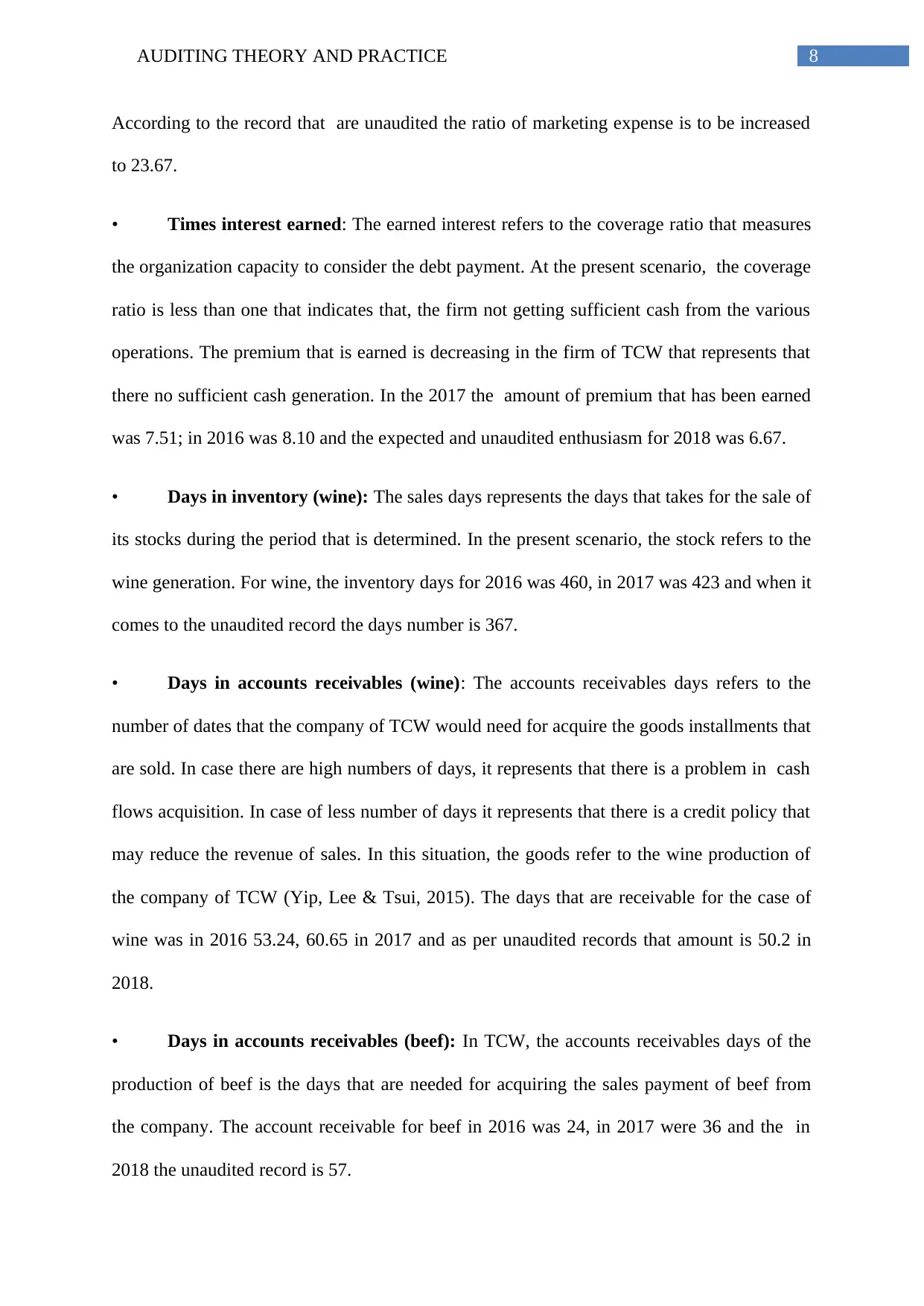
8AUDITING THEORY AND PRACTICE
According to the record that are unaudited the ratio of marketing expense is to be increased
to 23.67.
• Times interest earned: The earned interest refers to the coverage ratio that measures
the organization capacity to consider the debt payment. At the present scenario, the coverage
ratio is less than one that indicates that, the firm not getting sufficient cash from the various
operations. The premium that is earned is decreasing in the firm of TCW that represents that
there no sufficient cash generation. In the 2017 the amount of premium that has been earned
was 7.51; in 2016 was 8.10 and the expected and unaudited enthusiasm for 2018 was 6.67.
• Days in inventory (wine): The sales days represents the days that takes for the sale of
its stocks during the period that is determined. In the present scenario, the stock refers to the
wine generation. For wine, the inventory days for 2016 was 460, in 2017 was 423 and when it
comes to the unaudited record the days number is 367.
• Days in accounts receivables (wine): The accounts receivables days refers to the
number of dates that the company of TCW would need for acquire the goods installments that
are sold. In case there are high numbers of days, it represents that there is a problem in cash
flows acquisition. In case of less number of days it represents that there is a credit policy that
may reduce the revenue of sales. In this situation, the goods refer to the wine production of
the company of TCW (Yip, Lee & Tsui, 2015). The days that are receivable for the case of
wine was in 2016 53.24, 60.65 in 2017 and as per unaudited records that amount is 50.2 in
2018.
• Days in accounts receivables (beef): In TCW, the accounts receivables days of the
production of beef is the days that are needed for acquiring the sales payment of beef from
the company. The account receivable for beef in 2016 was 24, in 2017 were 36 and the in
2018 the unaudited record is 57.
According to the record that are unaudited the ratio of marketing expense is to be increased
to 23.67.
• Times interest earned: The earned interest refers to the coverage ratio that measures
the organization capacity to consider the debt payment. At the present scenario, the coverage
ratio is less than one that indicates that, the firm not getting sufficient cash from the various
operations. The premium that is earned is decreasing in the firm of TCW that represents that
there no sufficient cash generation. In the 2017 the amount of premium that has been earned
was 7.51; in 2016 was 8.10 and the expected and unaudited enthusiasm for 2018 was 6.67.
• Days in inventory (wine): The sales days represents the days that takes for the sale of
its stocks during the period that is determined. In the present scenario, the stock refers to the
wine generation. For wine, the inventory days for 2016 was 460, in 2017 was 423 and when it
comes to the unaudited record the days number is 367.
• Days in accounts receivables (wine): The accounts receivables days refers to the
number of dates that the company of TCW would need for acquire the goods installments that
are sold. In case there are high numbers of days, it represents that there is a problem in cash
flows acquisition. In case of less number of days it represents that there is a credit policy that
may reduce the revenue of sales. In this situation, the goods refer to the wine production of
the company of TCW (Yip, Lee & Tsui, 2015). The days that are receivable for the case of
wine was in 2016 53.24, 60.65 in 2017 and as per unaudited records that amount is 50.2 in
2018.
• Days in accounts receivables (beef): In TCW, the accounts receivables days of the
production of beef is the days that are needed for acquiring the sales payment of beef from
the company. The account receivable for beef in 2016 was 24, in 2017 were 36 and the in
2018 the unaudited record is 57.
⊘ This is a preview!⊘
Do you want full access?
Subscribe today to unlock all pages.

Trusted by 1+ million students worldwide
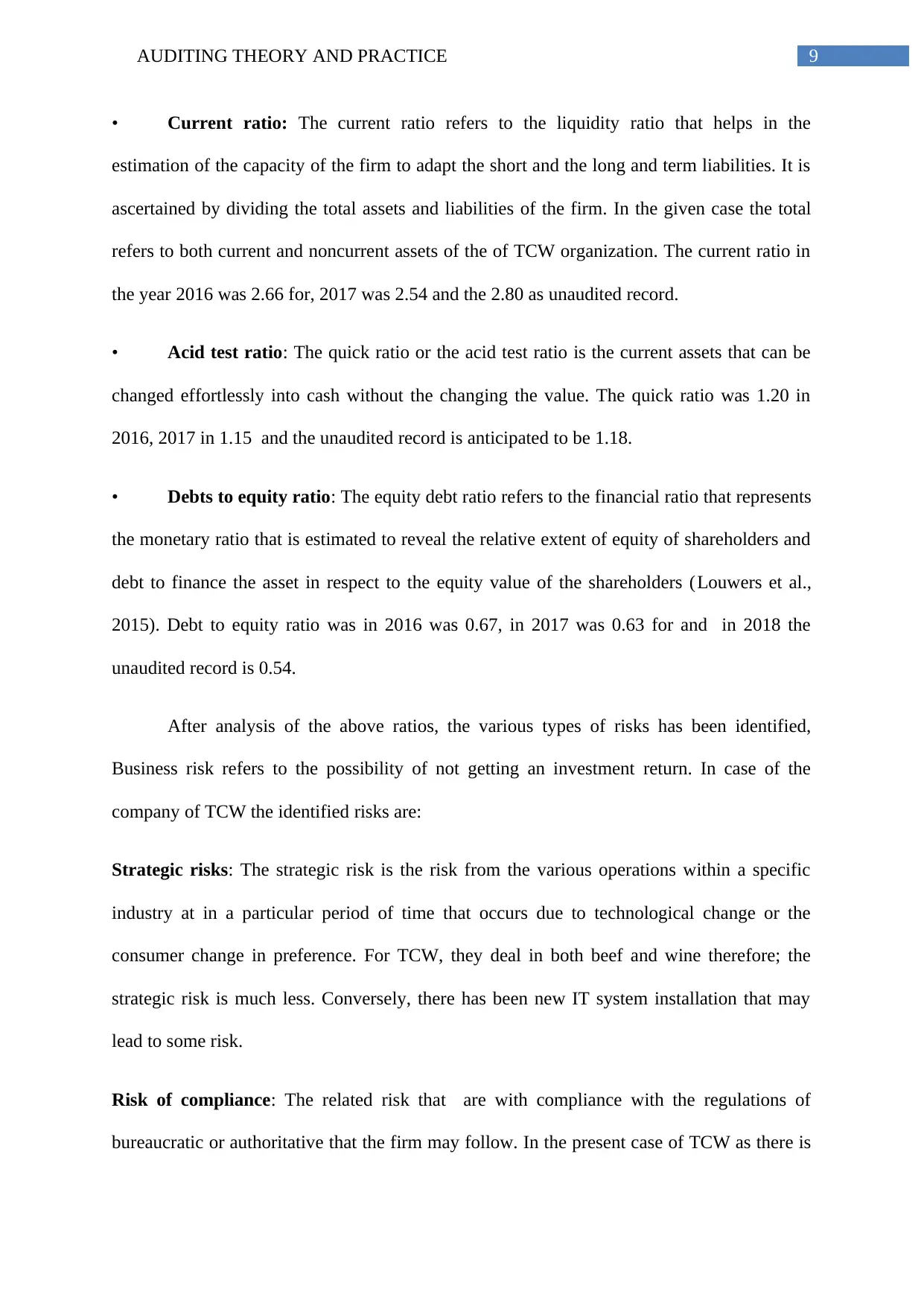
9AUDITING THEORY AND PRACTICE
• Current ratio: The current ratio refers to the liquidity ratio that helps in the
estimation of the capacity of the firm to adapt the short and the long and term liabilities. It is
ascertained by dividing the total assets and liabilities of the firm. In the given case the total
refers to both current and noncurrent assets of the of TCW organization. The current ratio in
the year 2016 was 2.66 for, 2017 was 2.54 and the 2.80 as unaudited record.
• Acid test ratio: The quick ratio or the acid test ratio is the current assets that can be
changed effortlessly into cash without the changing the value. The quick ratio was 1.20 in
2016, 2017 in 1.15 and the unaudited record is anticipated to be 1.18.
• Debts to equity ratio: The equity debt ratio refers to the financial ratio that represents
the monetary ratio that is estimated to reveal the relative extent of equity of shareholders and
debt to finance the asset in respect to the equity value of the shareholders (Louwers et al.,
2015). Debt to equity ratio was in 2016 was 0.67, in 2017 was 0.63 for and in 2018 the
unaudited record is 0.54.
After analysis of the above ratios, the various types of risks has been identified,
Business risk refers to the possibility of not getting an investment return. In case of the
company of TCW the identified risks are:
Strategic risks: The strategic risk is the risk from the various operations within a specific
industry at in a particular period of time that occurs due to technological change or the
consumer change in preference. For TCW, they deal in both beef and wine therefore; the
strategic risk is much less. Conversely, there has been new IT system installation that may
lead to some risk.
Risk of compliance: The related risk that are with compliance with the regulations of
bureaucratic or authoritative that the firm may follow. In the present case of TCW as there is
• Current ratio: The current ratio refers to the liquidity ratio that helps in the
estimation of the capacity of the firm to adapt the short and the long and term liabilities. It is
ascertained by dividing the total assets and liabilities of the firm. In the given case the total
refers to both current and noncurrent assets of the of TCW organization. The current ratio in
the year 2016 was 2.66 for, 2017 was 2.54 and the 2.80 as unaudited record.
• Acid test ratio: The quick ratio or the acid test ratio is the current assets that can be
changed effortlessly into cash without the changing the value. The quick ratio was 1.20 in
2016, 2017 in 1.15 and the unaudited record is anticipated to be 1.18.
• Debts to equity ratio: The equity debt ratio refers to the financial ratio that represents
the monetary ratio that is estimated to reveal the relative extent of equity of shareholders and
debt to finance the asset in respect to the equity value of the shareholders (Louwers et al.,
2015). Debt to equity ratio was in 2016 was 0.67, in 2017 was 0.63 for and in 2018 the
unaudited record is 0.54.
After analysis of the above ratios, the various types of risks has been identified,
Business risk refers to the possibility of not getting an investment return. In case of the
company of TCW the identified risks are:
Strategic risks: The strategic risk is the risk from the various operations within a specific
industry at in a particular period of time that occurs due to technological change or the
consumer change in preference. For TCW, they deal in both beef and wine therefore; the
strategic risk is much less. Conversely, there has been new IT system installation that may
lead to some risk.
Risk of compliance: The related risk that are with compliance with the regulations of
bureaucratic or authoritative that the firm may follow. In the present case of TCW as there is
Paraphrase This Document
Need a fresh take? Get an instant paraphrase of this document with our AI Paraphraser
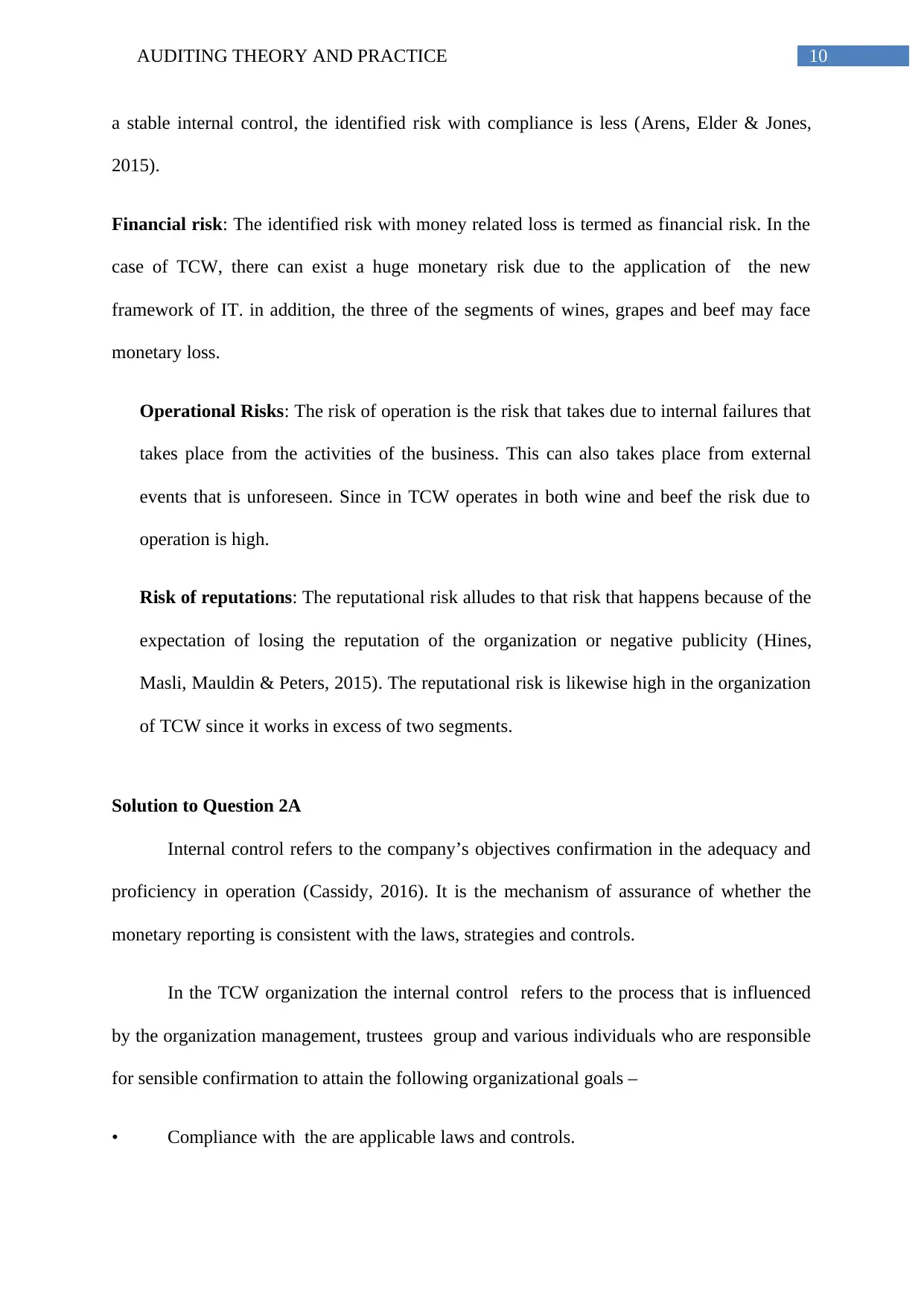
10AUDITING THEORY AND PRACTICE
a stable internal control, the identified risk with compliance is less (Arens, Elder & Jones,
2015).
Financial risk: The identified risk with money related loss is termed as financial risk. In the
case of TCW, there can exist a huge monetary risk due to the application of the new
framework of IT. in addition, the three of the segments of wines, grapes and beef may face
monetary loss.
Operational Risks: The risk of operation is the risk that takes due to internal failures that
takes place from the activities of the business. This can also takes place from external
events that is unforeseen. Since in TCW operates in both wine and beef the risk due to
operation is high.
Risk of reputations: The reputational risk alludes to that risk that happens because of the
expectation of losing the reputation of the organization or negative publicity (Hines,
Masli, Mauldin & Peters, 2015). The reputational risk is likewise high in the organization
of TCW since it works in excess of two segments.
Solution to Question 2A
Internal control refers to the company’s objectives confirmation in the adequacy and
proficiency in operation (Cassidy, 2016). It is the mechanism of assurance of whether the
monetary reporting is consistent with the laws, strategies and controls.
In the TCW organization the internal control refers to the process that is influenced
by the organization management, trustees group and various individuals who are responsible
for sensible confirmation to attain the following organizational goals –
• Compliance with the are applicable laws and controls.
a stable internal control, the identified risk with compliance is less (Arens, Elder & Jones,
2015).
Financial risk: The identified risk with money related loss is termed as financial risk. In the
case of TCW, there can exist a huge monetary risk due to the application of the new
framework of IT. in addition, the three of the segments of wines, grapes and beef may face
monetary loss.
Operational Risks: The risk of operation is the risk that takes due to internal failures that
takes place from the activities of the business. This can also takes place from external
events that is unforeseen. Since in TCW operates in both wine and beef the risk due to
operation is high.
Risk of reputations: The reputational risk alludes to that risk that happens because of the
expectation of losing the reputation of the organization or negative publicity (Hines,
Masli, Mauldin & Peters, 2015). The reputational risk is likewise high in the organization
of TCW since it works in excess of two segments.
Solution to Question 2A
Internal control refers to the company’s objectives confirmation in the adequacy and
proficiency in operation (Cassidy, 2016). It is the mechanism of assurance of whether the
monetary reporting is consistent with the laws, strategies and controls.
In the TCW organization the internal control refers to the process that is influenced
by the organization management, trustees group and various individuals who are responsible
for sensible confirmation to attain the following organizational goals –
• Compliance with the are applicable laws and controls.
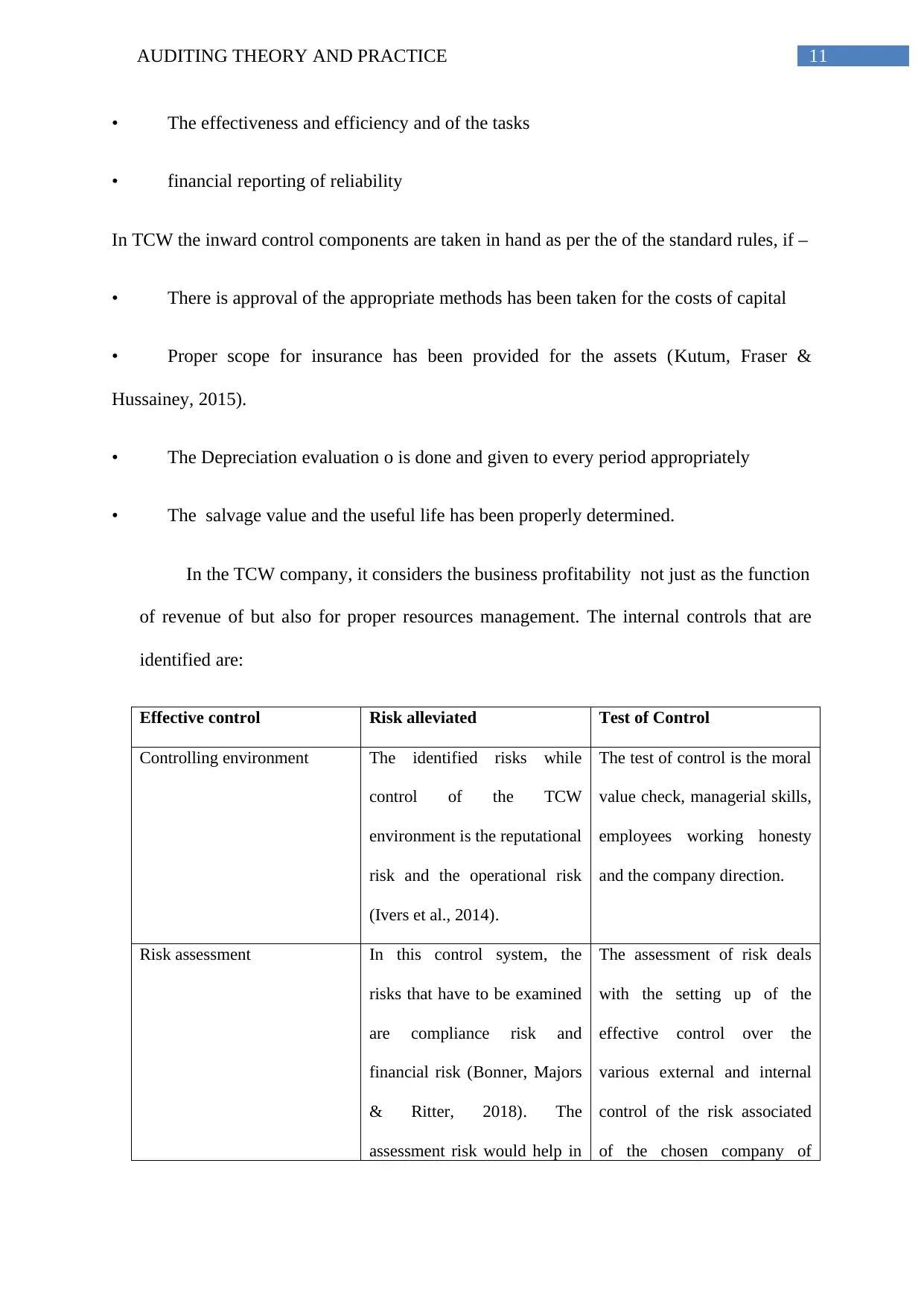
11AUDITING THEORY AND PRACTICE
• The effectiveness and efficiency and of the tasks
• financial reporting of reliability
In TCW the inward control components are taken in hand as per the of the standard rules, if –
• There is approval of the appropriate methods has been taken for the costs of capital
• Proper scope for insurance has been provided for the assets (Kutum, Fraser &
Hussainey, 2015).
• The Depreciation evaluation o is done and given to every period appropriately
• The salvage value and the useful life has been properly determined.
In the TCW company, it considers the business profitability not just as the function
of revenue of but also for proper resources management. The internal controls that are
identified are:
Effective control Risk alleviated Test of Control
Controlling environment The identified risks while
control of the TCW
environment is the reputational
risk and the operational risk
(Ivers et al., 2014).
The test of control is the moral
value check, managerial skills,
employees working honesty
and the company direction.
Risk assessment In this control system, the
risks that have to be examined
are compliance risk and
financial risk (Bonner, Majors
& Ritter, 2018). The
assessment risk would help in
The assessment of risk deals
with the setting up of the
effective control over the
various external and internal
control of the risk associated
of the chosen company of
• The effectiveness and efficiency and of the tasks
• financial reporting of reliability
In TCW the inward control components are taken in hand as per the of the standard rules, if –
• There is approval of the appropriate methods has been taken for the costs of capital
• Proper scope for insurance has been provided for the assets (Kutum, Fraser &
Hussainey, 2015).
• The Depreciation evaluation o is done and given to every period appropriately
• The salvage value and the useful life has been properly determined.
In the TCW company, it considers the business profitability not just as the function
of revenue of but also for proper resources management. The internal controls that are
identified are:
Effective control Risk alleviated Test of Control
Controlling environment The identified risks while
control of the TCW
environment is the reputational
risk and the operational risk
(Ivers et al., 2014).
The test of control is the moral
value check, managerial skills,
employees working honesty
and the company direction.
Risk assessment In this control system, the
risks that have to be examined
are compliance risk and
financial risk (Bonner, Majors
& Ritter, 2018). The
assessment risk would help in
The assessment of risk deals
with the setting up of the
effective control over the
various external and internal
control of the risk associated
of the chosen company of
⊘ This is a preview!⊘
Do you want full access?
Subscribe today to unlock all pages.

Trusted by 1+ million students worldwide
1 out of 18
Related Documents
Your All-in-One AI-Powered Toolkit for Academic Success.
+13062052269
info@desklib.com
Available 24*7 on WhatsApp / Email
![[object Object]](/_next/static/media/star-bottom.7253800d.svg)
Unlock your academic potential
Copyright © 2020–2025 A2Z Services. All Rights Reserved. Developed and managed by ZUCOL.




